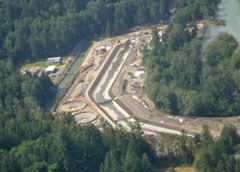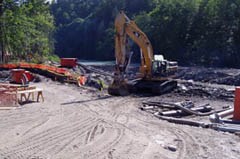
Elwha Water Facilities The Elwha River Ecosystem and Fisheries Restoration Act of 1992 requires “protection of the existing quality and availability of water from the Elwha River for municipal and industrial uses from [the] possible adverse impacts of dam removal” (Section 4(a)(3)). In the 90-plus years since the dams were built, large amounts of sediment have accumulated at the bottom of the two reservoirs, most of it in a delta at the head of Lake Mills. Extensive testing and modeling has shown that protection measures are necessary to meet the requirements of the Elwha Act. Elwha Surface Water Intake: 
The Elwha Water Treatment Plant: During high turbidity, it would allow the city to turn off the Ranney collector pumps to prevent plugging of the subsurface gravels. When times of high turbidity pass, the city could again send water from the Ranney collector to the PAWTP. Water treatment for the Lower Elwha Klallam Tribe fish hatchery and the WDFW rearing channel is necessary in order to protect anadromous fish stocks. The EWTP will supply filtered water for the hatchery and rearing channel in order to protect the fish from adverse conditions that may likely arise during dam removal. During dam removal, a portion of the rearing channel production of Elwha Chinook salmon will occur in off-channel ponds near Morse Creek. The high sediment transport period is expected to last from three to five years, depending on stream flows during that time. Higher stream flows would erode the sediments downstream faster than lower flow periods. The EWTP will only operate only during this three to five year period. Area Flood Protection: Useful Links:

|
Last updated: September 20, 2024
